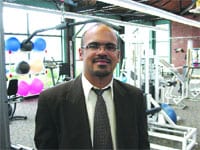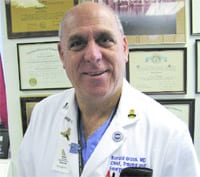Down Time Dr. Julio Martinez-Silvestrini Builds on His Dream of a Sports Clinic
As the team doctor for the New England Mutiny, a professional women’s soccer team based in Agawam, Dr. Julio Martinez-Silvestrini doesn’t have too much to complain about.
“I go to all the home games and address any injuries that occur during the game, as well as any older injuries that they may have from a previous season or previous game,” he said of his role with the squad. “And I have a team that’s very healthy. They do a lot of preparations to prevent injuries. They do a lot of stretches and strength training. Luckily, we haven’t had any major injuries during the season.”
The same sort of knowledge and preparation that keeps the Mutiny kicking, however, is in shorter supply when it comes to casual athletes of the type he sees every Monday at his sports clinic on Birnie Avenue in Springfield.
“My goal, when I started studying in medical school, was to have a sports clinic, and Baystate has given me the opportunity to work on that,” said Martinez-Silvestrini, who spends most of his time working with Baystate Physical Medicine and Rehabilitation Care. But as a specialist in sports medicine, he has seen the germ of an idea develop into a thriving, once-weekly clinic — one he would like to eventually expand to more days.
“We see any type of sports- or exercise-related injury. I see what we call ‘performing-arts injuries,’ for example, a dancer who had an ankle or foot injury or other types of overuse, such as carpal tunnel, tennis elbow, or injuries related to posture or repetitive activity. But our main focus is sports injuries.”
And Martinez-Silvestrini has seen this world from both sides, he said, giving him valuable insight into what it takes to stay healthy and injury-free.
“The fact that I was an athlete myself — I was a member of the Puerto Rican national weightlifting team — means I can really use my own experiences, combined with my medical knowledge, to give back to the athletes,” he told The Healthcare News.
“Our goal as a practice is to restore patients as close as possible to their normal function following an injury.”
Gaining Strength
Most patients in the clinic range from age 12 to collegiate, which makes sense in a region with only one professional sports team, the Mutiny.
“But we have all kinds of colleges that have their own teams, and each city has three or four high schools and middle schools,” he said. “So there are a lot more younger athletes here than adult or professional players.”
Martinez-Silvestrini, who earned his medical degree at the University of Puerto Rico and completed his sports medicine fellowship at the Mayo Clinic, said the clinic treats any kind of sports injury, but not surgical cases. “But most injuries aren’t operative,” he noted. “The most common injuries are ankle injuries, followed by knee and shoulder injuries, back injuries, and then there are some elbow, wrist, and neck injuries. But ankle sprains are the most common thing we see.”
The patients who show up aren’t always being treated for something new, he added, but often for chronic ailments or old injuries that are causing problems now. “When someone has a sports injury, we always educate the patient about different exercises they can do at home.”
And that includes both sides of the body; patients generally perform the same rehabilitative exercises on the healthy knee or ankle, for instance, and are expected to follow the proper exercise regimen on healthy joints to stave off future trips to the clinic.
“Our goal is not just to treat, but also to prevent other injuries,” said Martinez-Silvestrini, referring to a concept called the ‘kinetic chain,’ which posits that each part of the body directly affects the next. “You may develop a foot injury, and that may lead to a knee injury, then a hip injury, then a back injury. You may then come in for back pain, but we have to look at the patient as a whole, not just look at the complaint.”
He also teaches patients about proper recovery time from injuries. “For example, an ankle sprain is very common, and two weeks later you may be back playing,” he said. “But when you sprain your ankle, you lose some nerve endings that tell you where your ankle is in space, and where it is in relation to your foot.” That could lead to another ankle injury and, down the road, a weak ankle. “It’s important for us to educate the patient as to why their ankle is sprained and try to rehabilitate them.
“We don’t have a specific program where we see patients only to educate about injuries,” he was quick to add, “but if an athlete wants to come in and learn how to prevent an injury, they’re welcome.”
Solid Foundation
As he gave The Healthcare News a tour of the clinic space, lined with consultation stations, physical therapy beds, and exercise equipment, he talked of expanding the service in the future.
“This is my dream, and I want to continue to improve it,” he said. “My goal is to expand this to more days of the week. I started this clinic with two hours on Monday, 1 to 3. Then it was 1 to 5, and now it’s 1 to 7. It’s working out great.”
Because a physical therapist works at the weekly clinic, Martinez-Silvestrini called it a “one-stop shop where you can get your medical evaluation, initial exercises, and a physical therapy appointment, all in one visit.”
That’s important, because keeping injury-free can be a complex matter for those who don’t know all the facts. After all, not everyone’s a professional soccer player.



Comments are closed.